Requirements of the job: Tracking changes to the education component

Physical therapists are a Hot 50 occupation that experienced significant changes in educational requirements.
Changes in educational requirements for occupations occur for a variety of reasons. For example, professional organizations may change the requirements that they necessitate or advocate. Changes may also take place due to increases in the education level of workers—allowing employers to increase their requirements as they hire from a population with more credentials.1 To determine whether there has been educational attainment “deflation” or “inflation” for occupations, we compared the education levels of select occupations from 2004 to 2015 using O*NET 7 (released in 2004) and O*NET 20.1 (released in 2015).2
O*NET is sponsored by the U.S. Department of Labor’s Employment and Training Administration to collect data on an occupation’s characteristics, from education attainment to knowledge domains to the technologies used for a particular job. O*NET updates occupations annually across a range of data categories, including the following:
- Abilities
- Alternate titles
- Detailed work activities
- Education
- Interests
- Job zone
- Knowledge
- Sample of reported titles
- Skills
- Tasks
- Tools and technology
- Work activities
- Work context
- Work styles
- Work values
A broad swath of sources are used to update occupations:
- Job incumbents
- Occupational experts
- Analyst ratings
- Customer and professional associations
- Employer job postings
- Government programs
- Transactional data
- Web research
In this context, education attainment refers to the level of education that a set of incumbents have to perform the job. One might be tempted to call it “educational requirement” (indeed, one easily defaults to this term as a shorthand), but the data are based on a count of those in the occupation. If one out of 10 production line supervisors has a master’s degree, that is reflected in the O*NET data—along with the eight out of 10 that may only have a high school diploma. It is, therefore, a spectrum of education levels held by incumbents and the data delineate the “most common.”
The O*NET data are collected by asking either incumbent employees in the occupation or occupational experts about the “required” level of education needed to perform the job. But “required” here is more akin to the most common level of education for a particular occupation. O*NET does not make a distinction between a level of education that is literally required—say a master’s degree in clinical psychology to be a therapist—versus one that is competitively required to keep up with everyone else—perhaps a bookkeeper with a bachelor’s degree when all one technically needs is an associate degree.
For this analysis, we were particularly interested in three categories of occupations:
-
Indiana’s Hot 50 occupations: These are the fastest-growing, high-wage jobs of the future in Indiana. They are chosen based on criteria that includes short-term and long-term growth and job openings, as well as median wages. Some occupations that are included in the Hot 50 are elementary school teachers, accountants and physical therapists. A complete list of the Hot 50 occupations is available at https://netsolutions.dwd.in.gov/hh50/jobList.aspx.
-
High-wage/high-demand occupations: These are chosen using a scoring system that considers a number of factors, including whether the occupation pays higher than the state median wage, is expected to grow and is projected to have opportunities for new workforce entrants. Some occupations that are included in the high-wage/high-demand category are property/real estate managers, machinists, and electrical and electronics repairers. A complete list of the high-wage/high-demand occupations is available at www.hoosierdata.in.gov/dpage.asp?id=60&panel_number=2.
-
STEM occupations: STEM occupations are related to science, technology, engineering and mathematics. Some occupations that are included in the STEM category are licensed and practical vocational nurses, occupational therapists, and civil engineers. A complete list of the STEM occupations used in this analysis is available at www.incontext.indiana.edu/2016/nov-dec/STEMoccupationsIN.xlsx.
O*NET includes 12 levels of education requirements, but for this analysis, we combined them into seven categories:
- Less than a high school diploma
- High school diploma or equivalent
- Some college
- Associate degree
- Bachelor’s degree
- Master’s or first professional degree
- Doctoral degree
It is worth keeping in mind that O*NET is just one measure of the educational attainment needed for occupations. To understand what educational level is associated with different occupations according to four different federal sources, view this visualized comparison.
Results
Using the O*NET data, there has been a general shift toward occupations requiring more education since 2004. There has also been an increase in the average level of education required for occupations. Occupations within the specified occupational groups demonstrated greater increases when compared to all occupations.
For all occupations, there has been a decrease in the requirements of less than high school, high school and some college. There has been an increase during this time in the requirements of an associate degree, bachelor’s degree, master’s degree and doctoral degree. The largest change was the percent that required a high school diploma, decreasing by 3.8 percent (see Figure 1). The largest increase during this time was in the requirement of a bachelor’s degree, increasing by 2.6 percent.
Figure 1: Percent change in level of education required, 2004 to 2015
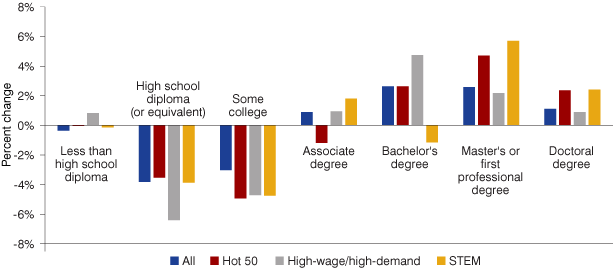
Source: O*NET 7 and O*NET 20.1
As an example, human resources specialists experienced a sharp decline in a high school diploma being the most common required level of education, going from 26.2 percent of respondents choosing that category to just 8 percent. Meanwhile, more respondents say that this occupation requires some college or a bachelor’s degree (see Figure 2).
Figure 2: Human resources specialist education requirements
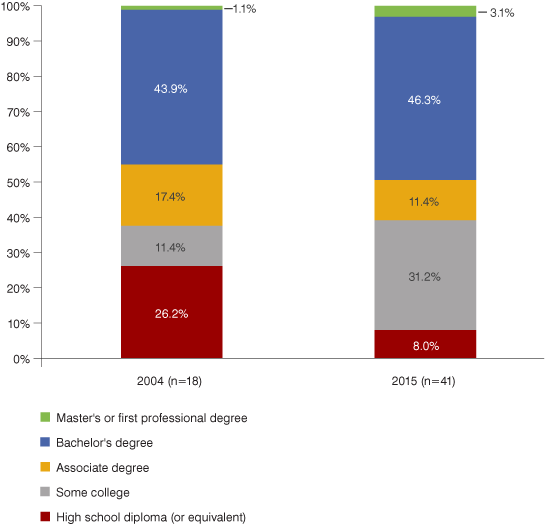
n = Number of respondents (incumbents or occupational experts) to the O*NET survey
Source: O*NET 7 and O*NET 20.1
Hot 50 occupations
The Hot 50 occupations follow a similar pattern to all of the occupations, except for a decrease in the percent requiring an associate degree. There was a decrease in the requirement of less than high school, high school degree, some college and associate degree. There was an increase in the requirement of a bachelor’s degree, master’s degree and doctoral degree. The largest decline in this group of occupations was in the requirement of some college (a 4.9 percent decrease), while the largest increase was in the requirement of a master’s degree at 4.7 percent.
Physical therapists are a Hot 50 occupation that experienced significant changes in educational requirements during this time. Physical therapy experienced an increase in master’s degree as a requirement, going from 36.8 percent to 50.2 percent, and an increase in doctoral degrees from 0 percent to 37.3 percent (see Figure 3). The American Physical Therapy Association released their Vision 2020 statement during this time period, declaring its initiative that all physical therapy “be provided by physical therapists who are doctors of physical therapy by 2020.”3 Physical therapists serve as an example of how professional organizations can drive the transformation of the educational requirements for certain occupations.
Figure 3: Physical therapy education requirements
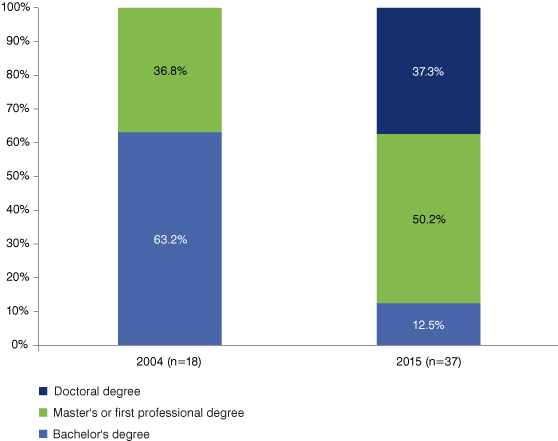
n = Number of respondents (incumbents or occupational experts) to the O*NET survey
Source: O*NET 7 and O*NET 20.1
High-wage/high-demand occupations
The high-wage/high-demand grouping experienced a slight increase in the percent of occupations requiring less than a high school degree. This is largely due to a significant increase in this requirement for certain occupations, such as bus and truck mechanics, food service managers and real estate agents. The high-wage/high-demand group also had an increase in the requirement of an associate degree, bachelor’s degree, master’s degree and doctoral degree. For this set of occupations, there was a decrease in the requirement of a high school degree and some college. The largest decline was in the requirement of a high school degree with a 6.4 percent decrease, while the largest increase was in the requirement of a bachelor’s degree with a 4.7 percent increase.
An example of a high-wage/high-demand occupation is electrical and electronics repairers. During this time, this occupation experienced a large decrease in the requirement of a high school diploma (decreasing from 36.4 percent to 0.6 percent) and a large increase in the requirement of an associate degree (rising from 11.6 percent to 45.9 percent), as shown in Figure 4.
Figure 4: Electrical and electronics repairers (commercial and industrial equipment) education requirements
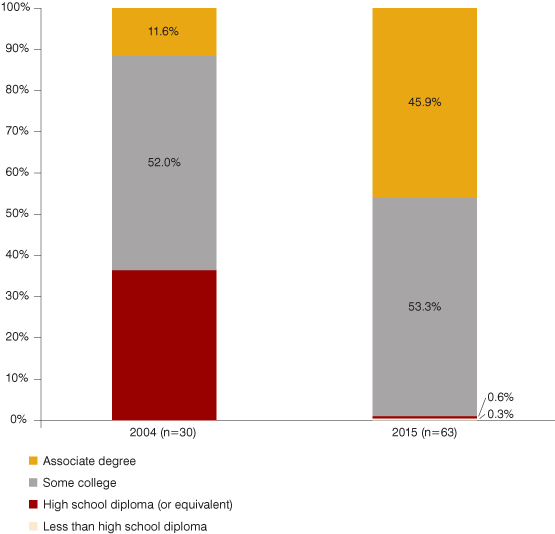
n = Number of respondents (incumbents or occupational experts) to the O*NET survey
Source: O*NET 7 and O*NET 20.1
STEM occupations
The STEM occupation group experienced a slight decrease in the percent requiring a bachelor’s degree for these occupations. Further analysis is needed, though this may be due to a polarization among STEM occupations between those requiring an associate degree and higher-level STEM occupations where a bachelor’s degree requirement is increasingly being replaced by a master’s degree.
For example, civil engineers experienced a decrease in the requirement of a bachelor’s degree from 89 percent to 56.5 percent and an increase in the requirement of a master’s degree from 4.6 percent to 39.1 percent (see Figure 5). For STEM occupations, the largest decline was in the requirement of some college (a 4.8 percent decrease), while the largest increase was in the requirement of a master’s degree with a 5.7 percent increase.
Figure 5: Civil engineer education requirements
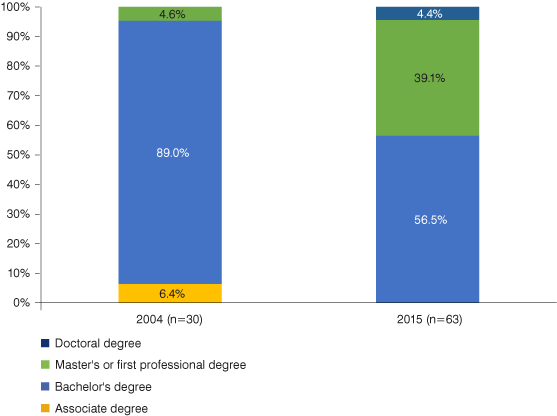
n = Number of respondents (incumbents or occupational experts) to the O*NET survey
Source: O*NET 7 and O*NET 20.1
Occupational therapists experienced a decline in the requirement of an associate degree from 17.3 percent to zero and bachelor’s degree from 72.6 percent to 19.1 percent. Meanwhile, master’s degree as a requirement went from 10.1 percent to 76.2 percent and doctoral degrees from zero to 4.8 percent. During this time, the board of directors for the American Occupational Therapy Association released the following statement: “In response to the changing demands of higher education, the health care environment, and within occupational therapy, it is the position of the American Occupational Therapy Association Board of Directors that the profession should take action to transition toward a doctoral-level single point of entry for occupational therapists, with a target date of 2025.”4
Figure 6: Occupational therapy education requirements
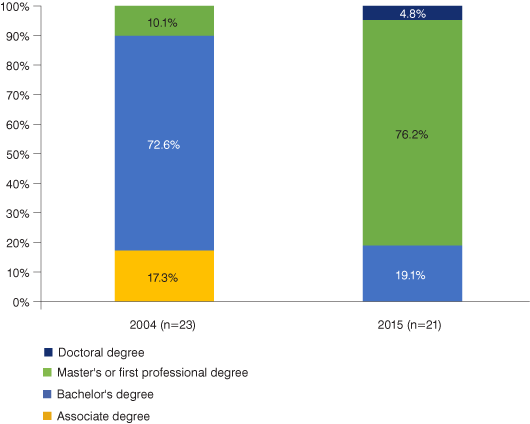
n = Number of respondents (incumbents or occupational experts) to the O*NET survey
Source: O*NET 7 and O*NET 20.1
Actuaries are an example of an occupation that has experienced something that goes against the trend of increasing education requirements. Actuaries experienced an increase in the requirement of a bachelor’s degree from 48.1 percent to 66.7 percent and a decrease in the requirement of a master’s degree from 51.9 percent to 33.3 percent. Actuaries are required to pass a series of examinations before they can become certified. In 2009, the Society of Actuaries began an accreditation system for universities that promoted undergraduate programs to prepare students for these exams, which helps explain the transition from master’s degrees to bachelor’s degrees as the most common requirement.5
Figure 7: Actuary education requirements
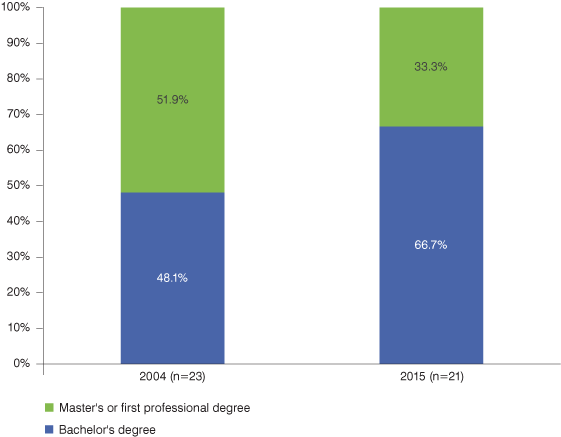
n = Number of respondents (incumbents or occupational experts) to the O*NET survey
Source: O*NET 7 and O*NET 20.1
Summary
Understanding the changes in occupation-level educational requirements has implications for what steps might be taken to prepare workers in Indiana for these occupations. Some may perceive the increases and decreases in education requirements across these occupations to be marginal, but remember that these changes are being observed over a relatively short time—just 11 years. When stepping away from the macro trends to investigate specific occupations, we see that education requirements have the potential to shift drastically in some cases, which may provide insight into why some employers experience difficulty in finding workers with a sufficient level of education for the job—with the result that certain occupations are changing faster than the workforce can adapt.
Want more data about an occupation we didn't mention?
Explore how the most common education requirement has changed between 2004 and 2015 for any occupation via our companion interactive charts.
Notes
- Catherine Rampell, “It Takes a B.A. to Find a Job as a File Clerk,” The New York Times, February 19, 2013.
- Not every occupation is included in both O*NET releases. This analysis only includes occupations with educational requirement information for both releases (n=245).
- “Vision 2020,” American Physical Therapy Association, July 13, 2015, www.apta.org/Vision2020/.
- “Update on the Entry-Level Degree for the Occupational Therapist Dialogue,” The American Occupational Therapy Association, July 31, 2015, www.aota.org/AboutAOTA/Get-Involved/BOD/News/2015/update-entry-level-degree-occupational-therapist-dialogue.aspx.
- “Universities and Colleges with Actuarial Programs,” Society of Actuaries, www.soa.org/Education/Resources/actuarial-colleges/actuarial-college-listings-details.aspx.
